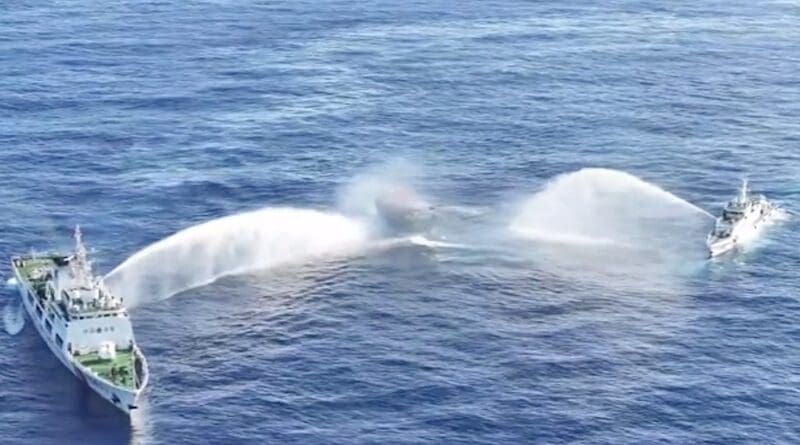WWIII
Clashing Courses In The South China Sea: The Philippines And China On A Collision Path – OpEd

China Coast Guard ships (left and right) deploy water cannons at the Philippine military-chartered civilian boat Unaizah May 4 (center) during its supply mission near Second Thomas Shoal in the disputed South China Sea. Photo Credit: Philippine Coast Guard (PCG) video screenshot
The South China Sea is a vital region global for trade and regional security. Unfortunately, tensions between China and the Philippines have transformed it into a highly disputed area. This essay aims to thoroughly examine the consequences of this dispute including its impact on regional tensions and unity within the Association of Southeast Asian Nations (ASEAN) maritime trade, international alliances legal frameworks environmental concerns and the possibility of armed conflict.
The South China Sea dispute not only escalates tensions between China and the Philippines but also relations strains other among Southeast Asian nations with overlapping territorial claims. China’s expansive claims depicted in the “Nine-Dash Line ” overlap with the exclusive economic zones (EEZs) of several ASEAN countries such as Malaysia Vietnam Indonesia, and Brunei. The Philippines supported by a 2016 ruling from the Permanent Court of Arbitration holds a particularly contentious position However, China’s refusal to acknowledge this ruling intensifies the standoff, leading to increased military activity and skirmishes that destabilise the region.
Implications for ASEAN Unity
The South China Sea dispute weakens ASEAN’s cohesion, which is crucial for maintaining unity among its member states. The principle of consensus and non-interference, which is integral to ASEAN, is also under significant strain due to conflicting interests and external pressures faced by member states.
Countries such as Cambodia and Laos, which have strong economic ties with China, often adopt a more conciliatory approach internally, thus creating divisions within ASEAN. As a result, the lack of consensus hampers ASEAN’s ability to present a united front and effectively mediate the conflict, thereby reducing its role as a regional stabilizer and diminishing its influence on the global stage.
Disruption of Maritime Trade
The South China Sea is a crucial global shipping route, with around one-third of all global shipping passing through its waters. Any disruptions caused by increased military activity or conflicts pose a significant risk to international trade and economic stability. For example, China’s construction of military installations on islands and its growing naval presence undermines the essential freedom of navigation for global supply chains. These disruptions could result in higher shipping costs, delays in deliveries, and broader negative impacts, particularly for economies heavily reliant on maritime trade.
The involvement of international alliances in the dispute over the South China Sea is of great importance for regional stability and global dynamics, with the United States playing a prominent role. As allies of the Philippines and supporters of freedom of navigation, the US conducts Freedom of Navigation Operations to challenge China’s territorial claims and defend international maritime rights. However, this involvement also carries the risk of escalating tensions between the world’s largest economies. Furthermore, the dispute has emboldened other major international powers such as Japan, Australia, and India, leading to increased military presence and strategic participation in the region, further complicating the geopolitical landscape.
One of the main challenges in resolving the conflict in the South China Sea is the enforcement of international maritime laws. In 2016, the ruling of the arbitral tribunal under UNCLOS was expected to create a legal framework for resolving disputes. However, China’s rejection of the ruling and its continued assertive actions have weakened the authority of international legal institutions. This situation emphasizes the limitations of international law when powerful nations refuse to comply, which sets a worrying precedent for similar territorial disputes globally.
Additionally, the militarization of the South China Sea has had devastating environmental consequences. China’s construction of artificial islands and military installations has caused significant damage to coral reefs and habitats, threatening the region’s biodiversity and the livelihoods of those who depend on marine resources. Furthermore, the increased naval operations raise the risk of accidents, oil spills, pollution, and other forms of environmental degradation, intensifying the ecological impact of the dispute.
The ongoing and escalating South China Sea dispute increases the chances of accidental or deliberate armed conflicts. With multiple countries deploying military vessels and aircraft, any miscalculations or provocations could quickly escalate into larger conflicts, causing serious consequences for both regional and global stability. The potential human, economic, and environmental costs associated with armed conflicts in this area are significant. The South China Sea dispute extends beyond legal and diplomatic complexities. It poses risks not only to the stability of global and peaceful coexistence among nations but also to environmental well-being. Resolving this dispute necessitates a delicate balancing act of diplomatic efforts, adherence to international law, and a strong commitment to multilateral collaboration.
In summary, the clashes between China and the Philippines in the South China Sea present a complex challenge to regional peace and stability. This dispute not only heightens tensions in the region but also undermines the unity of the Association of Southeast Asian Nations (ASEAN) and disrupts maritime trade. Additionally, it invites increased international involvement, thereby raising the likelihood of broader conflicts.
Conclusion
There are significant obstacles to finding a comprehensive resolution to this issue, both from legal and diplomatic perspectives. Additionally, the militarization of the area poses long-term threats to the well-being of the region. To effectively address this conflict, a holistic approach is necessary, which involves diplomatic engagement, legal frameworks, and regional cooperation. Such an approach is crucial for maintaining peace and stability in the South China Sea.
The opinions expressed in this article are the author’s own.
References
- Batongbacal, J. A. (2016). “The South China Sea Arbitration: Implications for Maritime Law and Security in Asia.” Asian Journal of International Law, 6(1), 137-154.
- Beckman, R. (2013). “The UN Convention on the Law of the Sea and the Maritime Disputes in the South China Sea.” American Journal of International Law, 107(1), 142-163.
- Cronin, P. M., & Kaplan, R. D. (2012). “Cooperation from Strength: The United States, China and the South China Sea.” Center for a New American Security.
- Glaser, B. S. (2015). “Conflict in the South China Sea.” Council on Foreign Relations.
- McManus, J. W. (2017). “The Spratly Islands: A Marine Park Solution.” Ambio, 46(7), 771-785.
- Poling, G. B. (2020). “Illuminating the South China Sea’s Dark Fishing Fleets.” Center for Strategic and International Studies.
- Thayer, C. A. (2017). “ASEAN, China and the Code of Conduct in the South China Sea.” Maritime Security in the Indo-Pacific, 53-

Simon Hutagalung is a retired diplomat from the Indonesian Foreign Ministry and received his master's degree in political science and comparative politics from the City University of New York. The opinions expressed in his articles are his own.
No comments:
Post a Comment